14.Napoleonic Decade (1806-1815)
14.Napoleonic Decade (1806-1815)
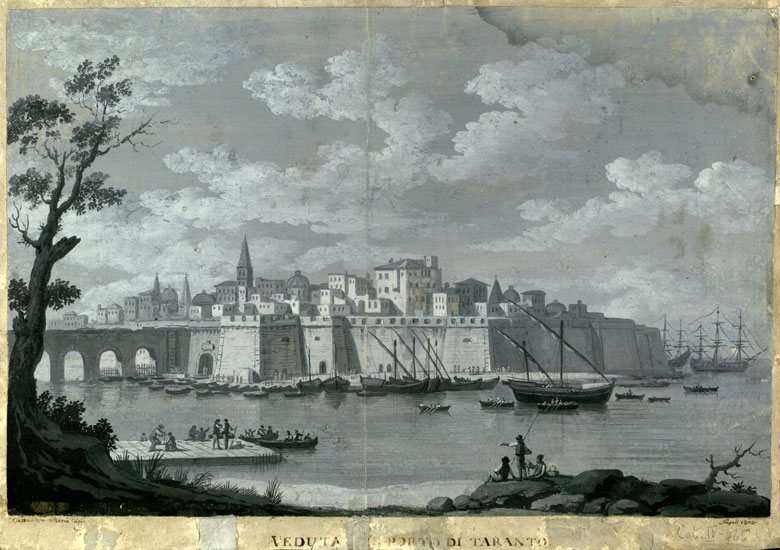
1806
1806
Napoleon transforms Taranto into a military port
Napoleon had a survey carried out on the port of Taranto to determine the measures required to ensure it operated as efficiently and securely as possible. The work on the harbour was carried out in a very short time; it mainly concerned the wide harbour mouth, which was fortified at its entry points: batteries were installed on the island of S.Paolo and at Punta Rondinella. Capo di S.Vito was fortified and the anchorage of the merchant port was restructured. With the law repealing feudalism in 1806, the rights over Taranto's fishing grounds were abolished, so the number of fishermen increased. View of the port of Taranto, by Alessandro D'Anna, 1802. Dis. 10714, 8F.2(1. Biblioteca della Società Napoletana di Storia Patria, (Library of the Neapolitan Society of National History), Naples. Image published with the permission of the Società Napoletana di Storia Patria (Neapolitan Society of National History). Further reproduction is prohibited.
1807
1807
The port of Taranto as described by geographer Giuseppe Pacelli
In the early 19th century, the Mandurian geographer Giuseppe Pacelli (1764-1811) drew a series of maps of the entire Salento region, later referred to as the Atlante Salentino (Salento Atlas). In the description of Taranto that accompanies the map, Pacelli calls the Taranto port 'one of the best in the Kingdom. It is vast and secure, in the shape of a theatre, about 18 miles round, and capable of accommodating any kind of vessel, even warships.' Map of the port of Taranto drawn by Giuseppe Pacelli, Biblioteca Pubblica Arcivescovile ``A. De Leo`` (The Annibale De Leo Archdiocesan Public Library), Manuscript Collection, ms. N9. GIUSEPPE PACELLI, The Salento Atlas of the Province of Otranto divided into its ecclesiastical dioceses, 1803.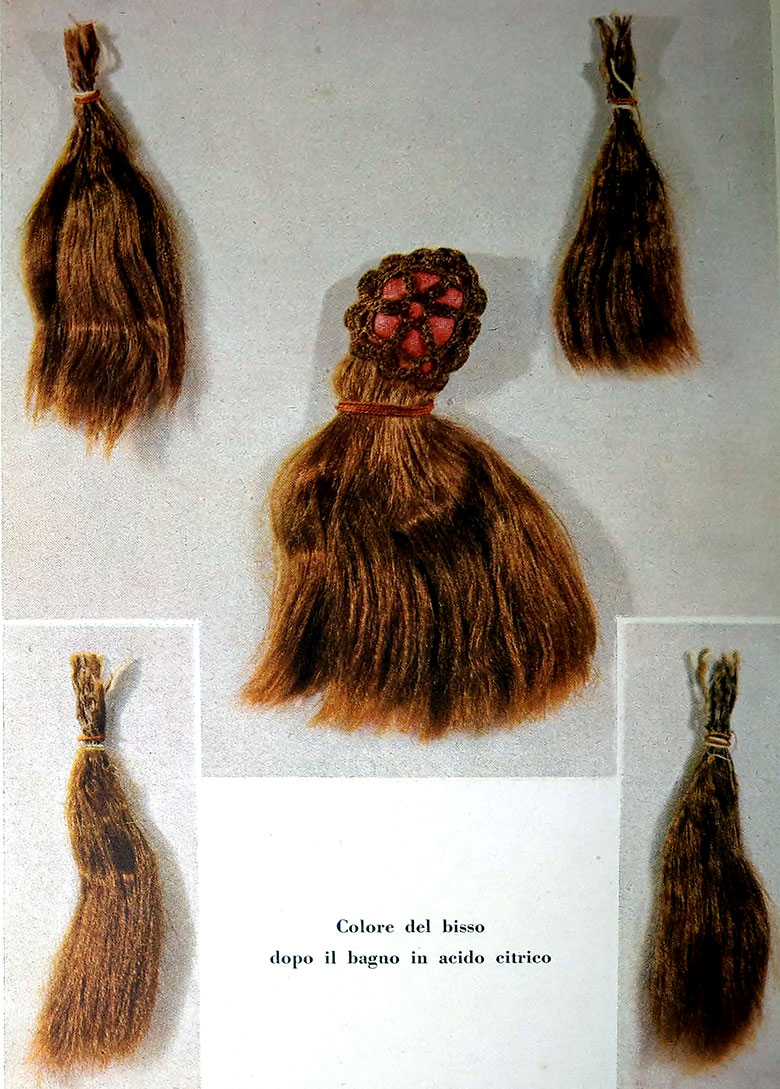
1810
1810
The processing of byssus or «Pen shell wool»
One of the distinctive features of Taranto in the early 19th century was the manufacture of byssus (or 'pinna `{`pen shell`}` wool'), owing to the large quantity of a genus of mollusc, the pinna nobilis, fished there. The strands produced by the mollusc give a thread from which gloves and stockings, sought after inside and outside the kingdom, were made. In addition, the port of Taranto continued to be the hub for the collection of cereals from the Otranto region, and producing biscuits (about 1200 quintals `{`120 tonnes`}` per year) to supply armies and ships. Tufted byssus from Bollettino della Provincia Ionica (Bulletin of the Ionian Province), April 1928, year II, n.1-2.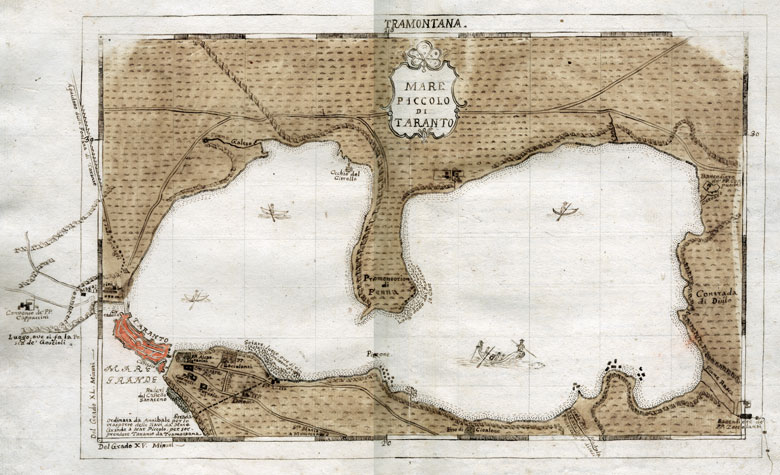
1811
1811
The workings of the port in a description by Abbot Gagliardo
The Tarantine abbot Giovan Battista Gagliardo, in his Topographical Description of Taranto (1811), mentions the population of twenty thousand inhabitants, emphasising that «it is made up of two-thirds fishermen and sailors».And in describing the port's trade, he writes that «oils and wheat are sent out of the state, as well as all kinds of grain, civaje `{`legumes`}`, wine, potash, wool, cotton, rags, skins, cheese, honey, dried fruit, knitted and woven cotton, 'Pinna wool' work, and other things.
For this purpose, there are two cargo loaders, by means of which import and export is made convenient and rapid.» Map of the Mar Piccolo (Little Sea), Taranto drawn by Giuseppe Pacelli, Biblioteca Pubblica Arcivescovile ``A. De Leo`` (The Annibale De Leo Archdiocesan Public Library), Manuscript Collection, ms. N9. GIUSEPPE PACELLI, The Salento Atlas of the Province of Otranto divided into its ecclesiastical dioceses, 1803.
15. Second Bourbon period (1815-1860)
15. Second Bourbon period (1815-1860)
1815
1815
Congress of Vienna, leading to the Restoration.

1816
1816
With the return of the Bourbons, the development of the port slows down
On his return as ruler, King Ferdinand (1751-1825) abolished the 'Ponti e Strade' (``Bridges and Roads``) authority that dealt with merchant ports, established by the French. With the enactment of the new navigation law (1826) during the brief reign of Francis I (1825-30), there was an expansion of the merchant fleet, partly because the law facilitated the construction of merchant ships. Port infrastructure, however, remained inadequate. The Port of Taranto by Jacob Philipp Hackert, 1789 https://commons.wikimedia.org/wiki/File:Jakob_Philipp_Hackert_-_Porto_di_Taranto_(1789).jpg Jacob Philipp Hackert, Public domain, via Wikimedia Commons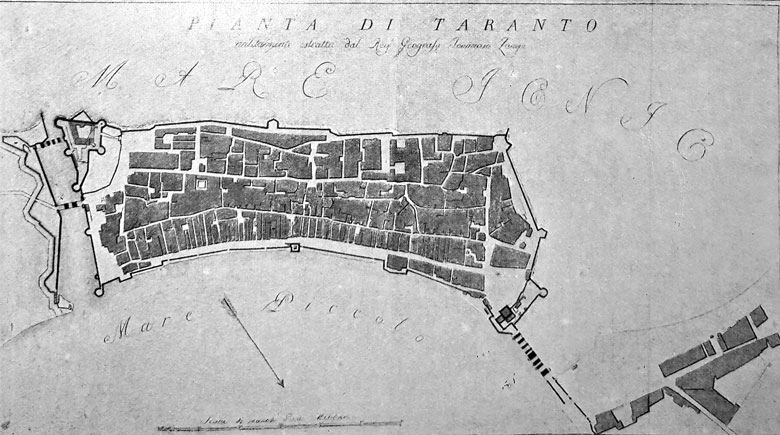
1848
1848
Construction of a new quay.
The municipality of Taranto had a 67-metre quay built in the merchant port, with small overhanging projections, useful for loading and unloading the fish and mussels for market.In the same period, a new road network allowed greater traffic between the previously poorly connected Apulian provinces, making the sea routes less essential. Plan of Taranto in the first half of the 19th century, from Giuseppe Carlo Speziale, Storia militare di Taranto negli ultimi cinque secoli (The Military History of Taranto Over The Last Five Centuries), Bari, Laterza 1930.
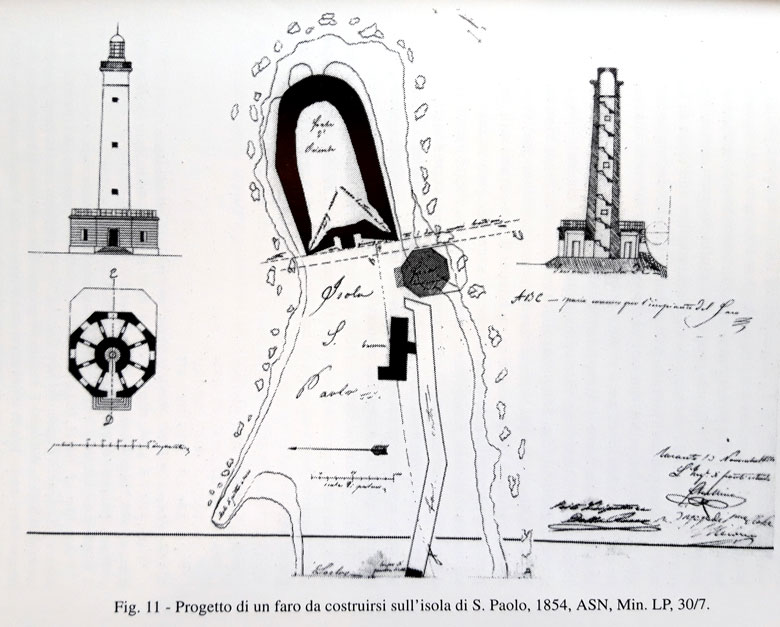
1854
1854
Two new beacons are planned for the harbour entrance.
A ministerial report states that the 'small, low lantern at Capo S.Vito that marks the entrance to the port of Taranto' is insufficient and its light needs to be enhanced, with the addition of a 'small lantern' on the island of San Paolo to indicate the entrance channel. Lighthouse project for the island of San Paolo, 1854 from AA VV, Il porto di Taranto tra passato e presente (The port of Taranto between the past and the present), Conference proceedings: Taranto, 28 October 1997, Cressati, Taranto 1998.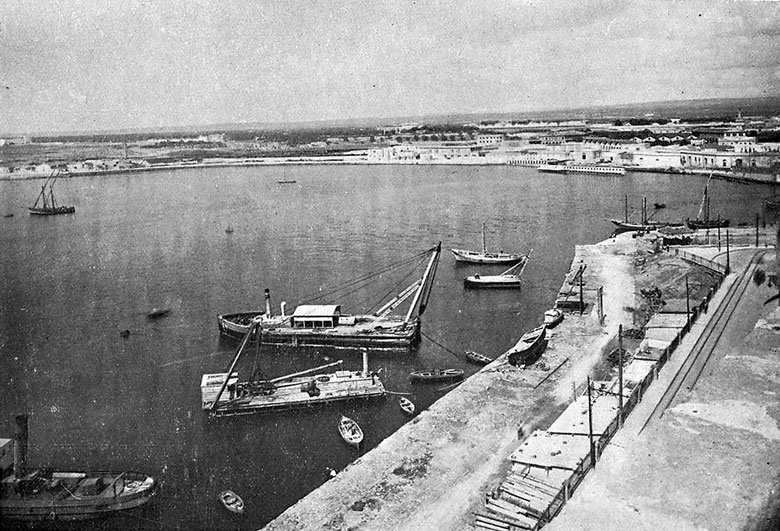
1857
1857
New works at the merchant port.
In the same ministerial report it addresses ``the bad condition of Taranto harbour, its restoration has been ordered since 1853, and therefore 400 spans of quay will be built from the Telegraph office to the Cittadella Tower in front of the Customs House with ladders and mooring posts, excavating out the corresponding part of the sea to 12 spans there, and 18 spans for the remainder, at the expense of 28,300 ducats. Once this more urgent work has been completed, the above-mentioned quay can be extended by another 340 spans as far as the bridge in front of Porta di Napoli at a cost of another 19,000 ducats``. View of the merchant harbour from the Convent of San Giovanni, c. 1930 from Rassegna del Comune (Municipal Review), 1934, vol. 7-8, www.internetculturale.it16. Post-Unification period (1861-1900)
16. Post-Unification period (1861-1900)
1861
1861
Unification of Italy
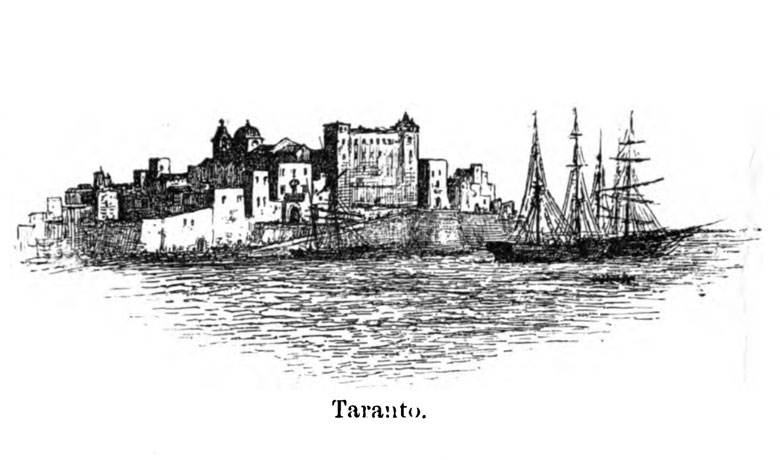
1861
1861
The City Council calls for new infrastructure to develop the port
The merchant port, which had declined under the last Bourbons, was the focus of the administrators' attention. The city council of Taranto commissioned the architect Conversano to go to Turin, the first capital of post-unification Italy, to ask the Minister of Public Works to authorise measures that were essential for the city's development. Works that primarily concerned the port and its infrastructure, to promote trade and manufacturing operations. View of Taranto from the merchant harbour, c. 1889. From Janet Ross, The Land of Manfred, Prince of Tarentum and King of Sicily, London 1889 fromhttp://books.google.com1869
1869
Opening of the Suez Canal
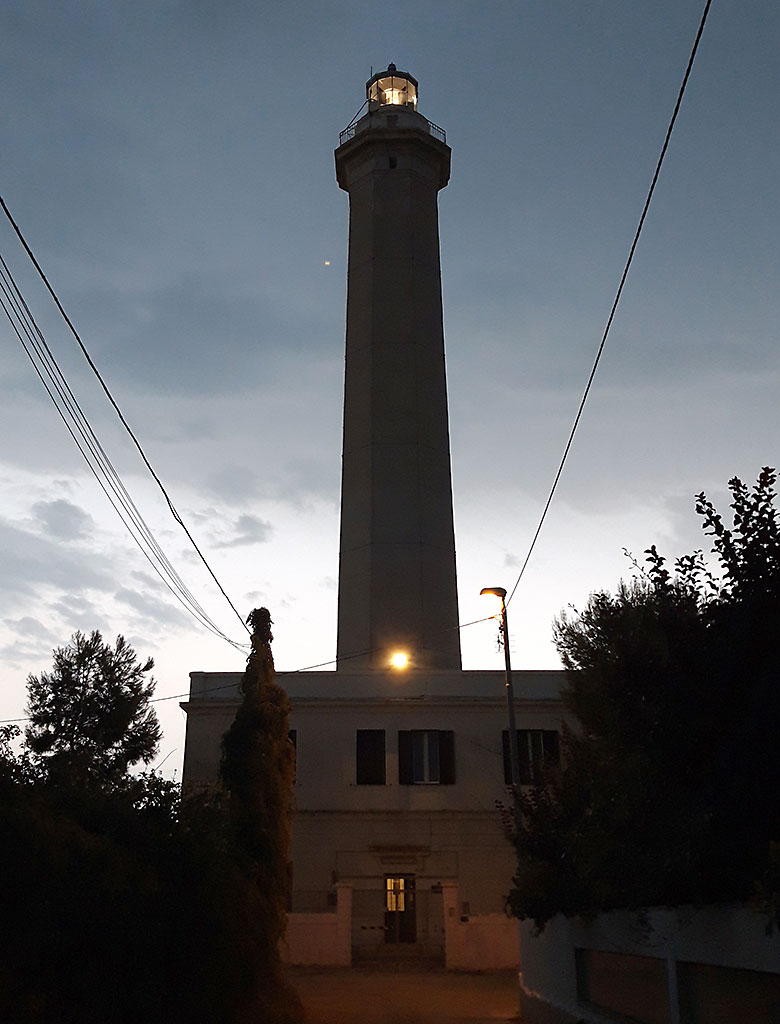
1869
1869
Construction of the Capo S.Vito lighthouse
The new lighthouse was switched on, replacing a 'small, low lantern'. The light was placed on a 43-metre high cylindrical white tower and, together with the lighthouse on the island of St. Paul, marked the entrance passage into the harbour mouth. Lighthouse at Cape San Vito that signals the entrance to the harbour. Photo Salvatore Tomai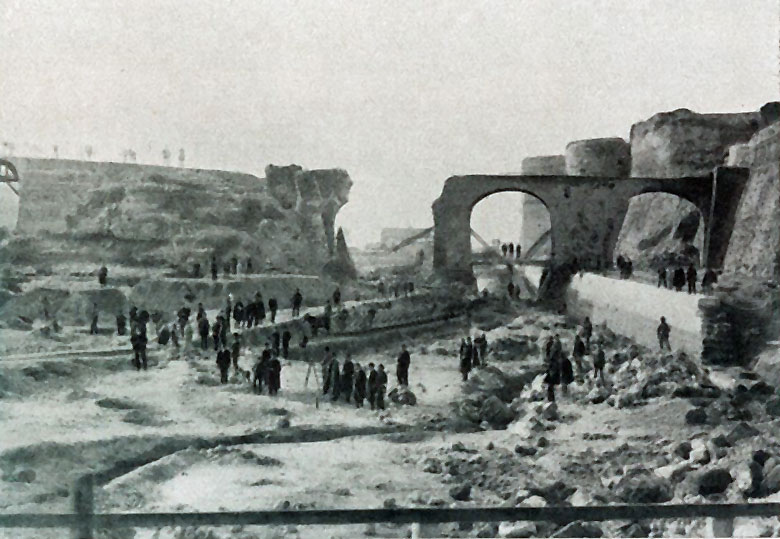
1881
1881
Work begins on a new Military Arsenal and the Swing Bridge
The Arsenal works included the dry dock in the Mar Piccolo and the excavation of the navigation canal. The masonry bridge at Porta Lecce was demolished and construction began on the new iron bridge, designed in two sections that rotated on their axes to allow the passage of high-masted ships. Works in the Fosso (``The Ditch``) for the opening of the Navigation Canal and construction of the swing bridge, 1883 from Rassegna del Comune (Municipal Review) 1935, vol. 3-4,, www.internetculturale.it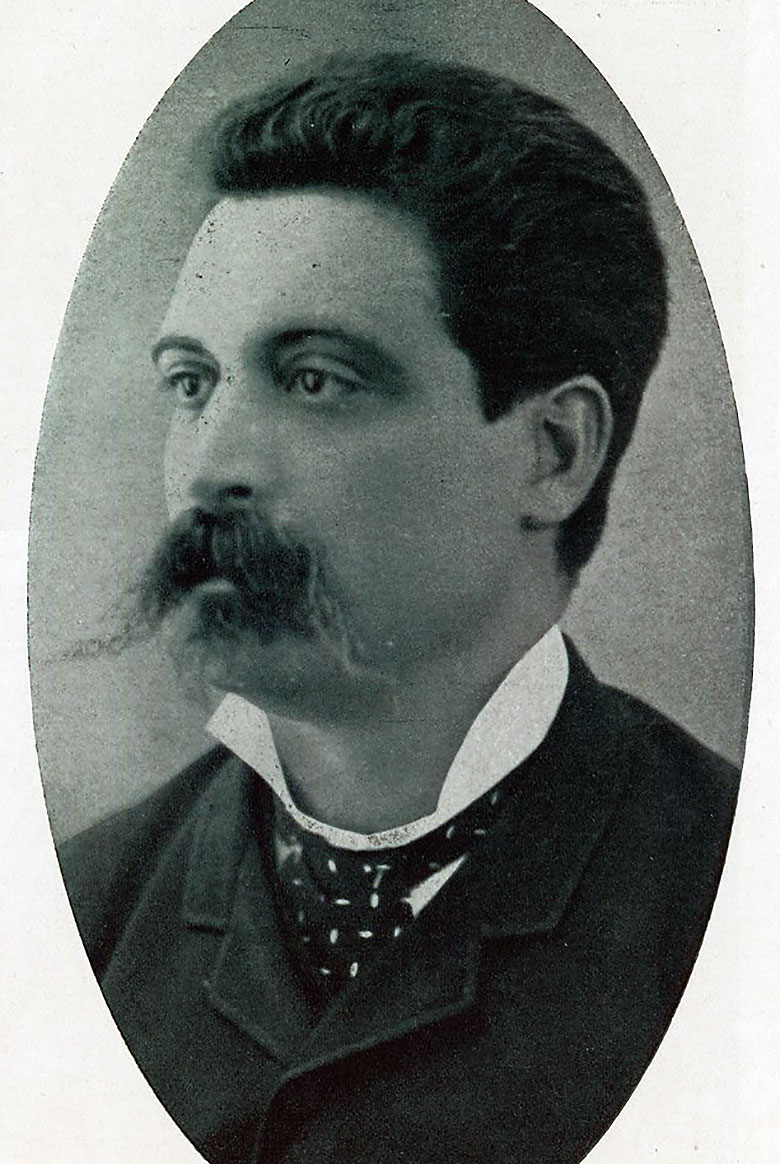
1881
1881
The jetties of the ancient trading port come to light
In 1881, the archaeologist Luigi Viola (1851-1924), observed some rows of large square blocks submerged along the lido in the Mar Piccolo, between the former convent of St. Anthony and the military hospital. These blocks were interpreted as parts of the city walls, but modern scholars believe instead that they are the remains of two large jetties that enclosed the harbour basin of Taranto's ancient commercial port, not least because many of amphorae used in ancient times for transportation by sea have been found there. Luigi Viola from Rassegna del Comune (Municipal Review) 1935, vols. 3-4, www.internetculturale.it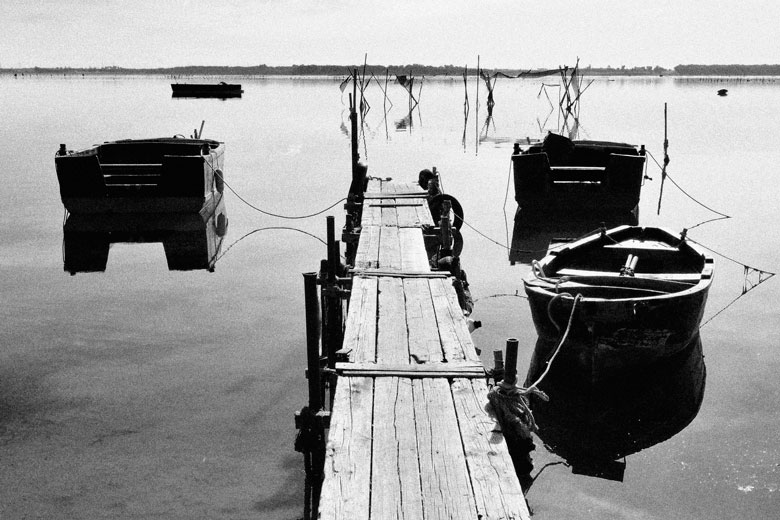
1885
1885
Law reagrding Ports, Beaches and Lighthouses
In the Royal Decree 3095 of 2 April 1885, the port of Taranto was not included in any category because its commercial importance was still being evaluated, pending the excavation of the seabed and the construction of a landing quay. Small jetty in Mar Piccolo (``Little Sea``), Photo by Sergio Malfatti.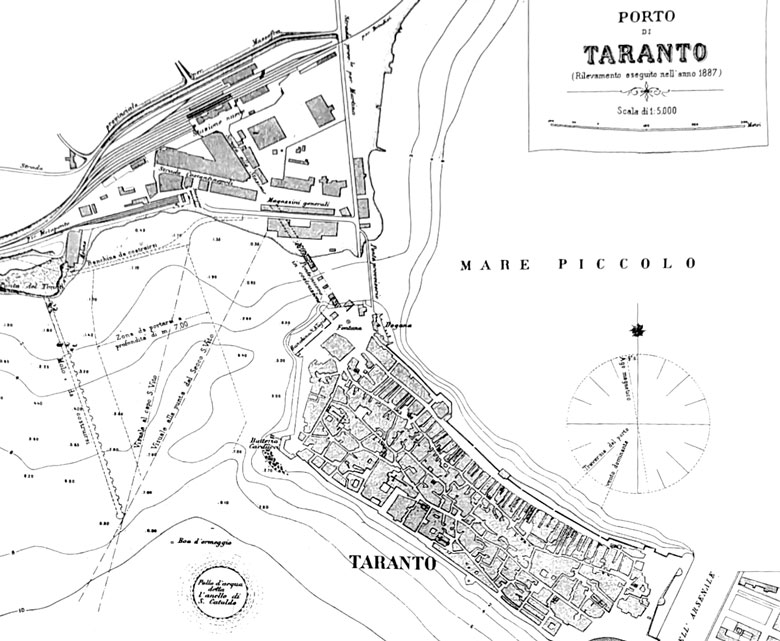
1886
1886
New wharf at the St. Eligius quay
With government subsidies, a new quay was built at the S. Eligio quay, although it was considered far from the railway station and too exposed to winds from the east and south. One of the most dangerous winds is the libeccio (south-westerly wind), especially in winter, although it is rare and short-lasting, like the scirocco, which with its strength can disturb ships moored in the harbour. Survey of the port of Taranto, 1887 by AA VV, The port of Taranto, Consorzio Area Sviluppo Industrale (Consortium for Industrial Development), Rome 1978.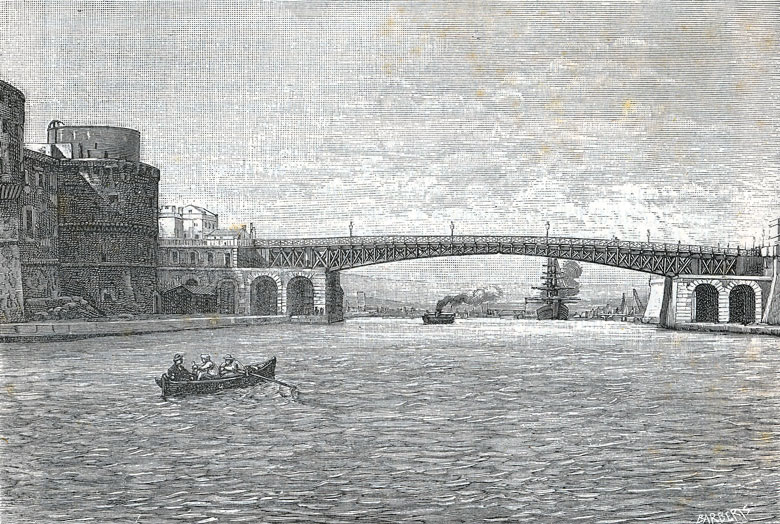
1887
1887
Inauguration of the Swing Bridge
After five years of work that first saw the 'cutting' of the navigation canal, and the demolition of a tower of the Aragonese Castle and three towers of the city wall, the Ponte Girevole was inaugurated in the presence of the Minister of the Navy, Ferdinando Acton (1832-1891). Ponte girevole chiuso (The Swing Bridge Closed), xylograph by Giuseppe Barberis 1898 from Strafforello Gustavo, La patria, geografia dell'Italia (The land, geography of Italy) / Part 4. Provinces of Bari, Foggia, Lecce, Potenza, Unione Tipografico-Editrice, Turin, 1899.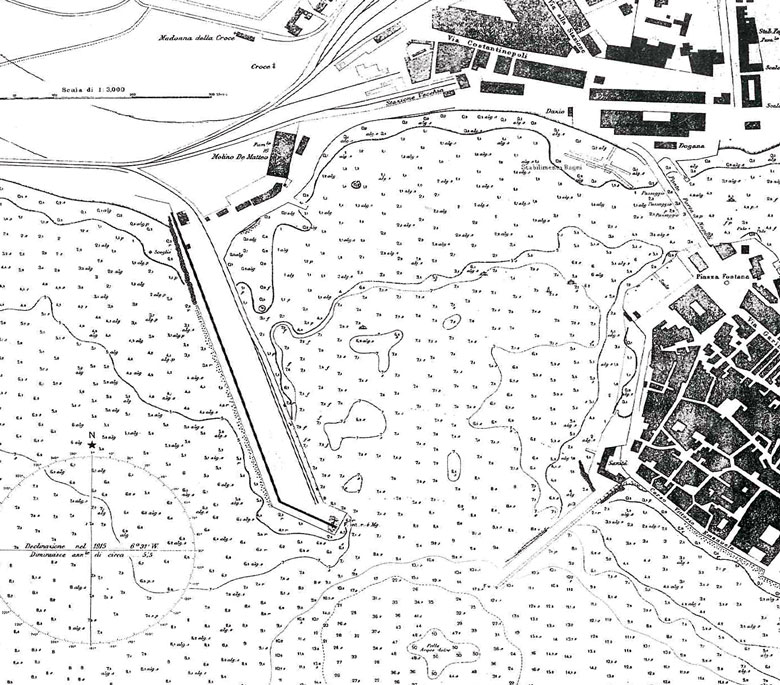
1888
1888
The merchant port at the end of the 19th century
The Port was classified as belonging to Series II, second category, i.e. it became part of the 'ports and landing places that serve primarily for trade'. At that time, it «has four quays, the main one, the western one, is 401 metres long, and is served by railway connections, water and electricity systems; the General Warehouses also stand on it. In addition to the western quays, there are three other mooring points, a quay with a 138 m long frontage, another 100 m long, and the 200 m long ``eastern`` quay, with a dock that is 169 m long and 12 m wide.» The Merchant Port of Taranto in 1915 from AA VV, The port of Taranto, Consorzio Area Sviluppo Industrale (Consortium for Industrial Development), Rome 1978.
1889
1889
Inauguration of the Military Arsenal
While the creation of the Arsenal increased the military function of the port, it also contributed to the establishment of a number of small and medium-sized industries, which consequently added to the importance of the merchant port, which then received new funding for expansion. Plan of the port of Taranto in 1887 from AA VV, The Port Of Taranto, Consorzio Area Sviluppo Industrale (Consortium for Industrial Development), Rome 1978.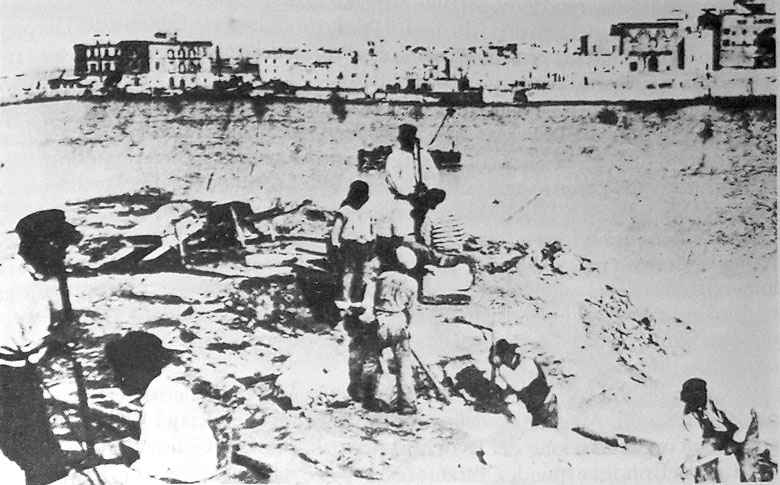
1899
1899
Archaeological excavations provide evidence of a Bronze-Iron Age settlement
During the excavation of the Scoglio del Tonno (Tuna Rock), a promontory west of the mouth of the Mar Piccolo, for the construction of a jetty, the remains of an ancient Bronze Age settlement came to light. Evidence of an active and growing community, over a period of time ranging from the Middle Neolithic to the 12th century B.C., had already been found in the area: eg. the practice of inhumation in 'cave' tombs, the use of red ochre in funerary rites and Mycenaean ceramics, suggesting the presence of an actual Mycenaean settlement. Excavating the Tuna Rock from AA VV, Taranto da una guerra all'altra (Taranto from one war to another), Mandese, Taranto 1986.17.Early 20th century (1900-1914)
17.Early 20th century (1900-1914)
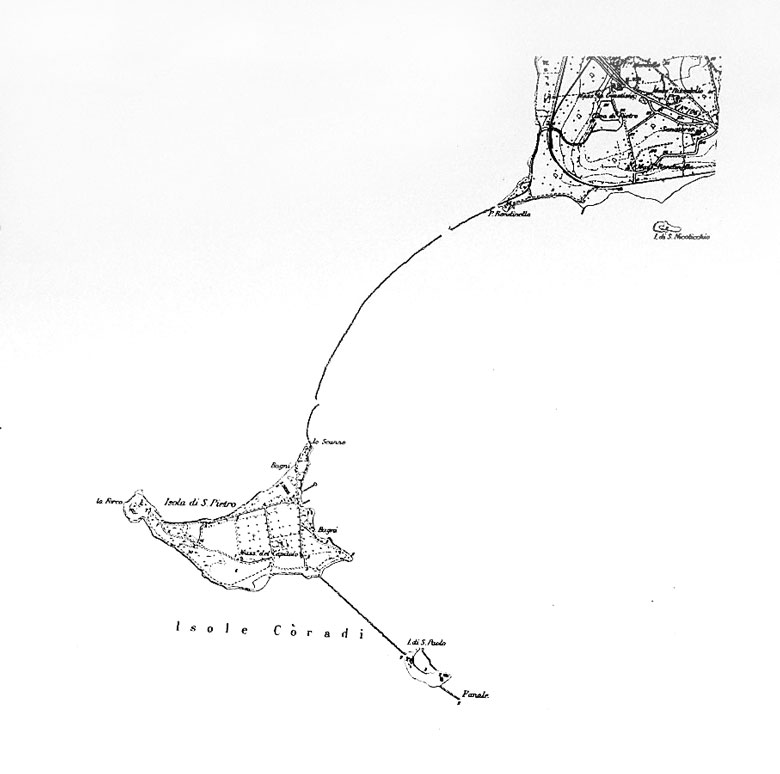
1906
1906
Works to expand the port basin
A series of works in the harbour were completed: a straight jetty about 400 metres long ending in a short ``hammer arm`` breakwater, which limits the far inner angle of the Mar Grande. The jetty was part reef, part quay; and it was hoped in this way to significantly dampen the waves caused by both the sirocco and libeccio, but it did not have the desired effects. So much so that steamships continued to moor in the stretch between S. Eligio and the Carducci Battery, while sailing ships continued to dock at the S. Eligio cove, and cargo operations proceeded by means of lighter craft. Drawing of the breakwater between Punta Rondinella and the island of S.Paolo, passing through the island of S.Pietro, from AA VV, Il porto di Taranto (The Port of Taranto), Consorzio Area Sviluppo Industrale (Consortium for Industrial Development), Rome 1978.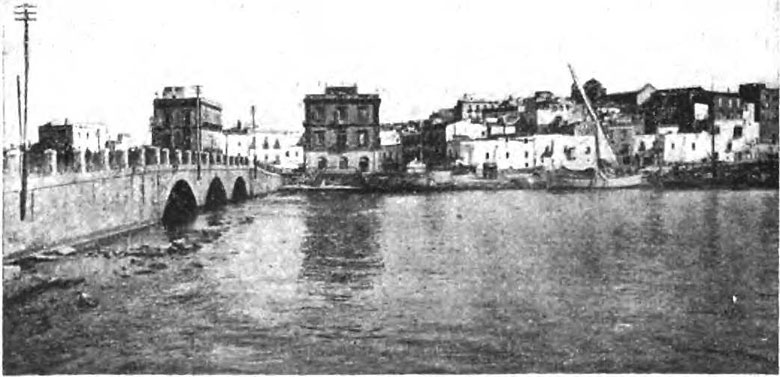
1911
1911
Goods traffic in the port on the rise
The import of coal, especially for the navy and railways, is very significant, as is, to a lesser extent, that of lime, cement, iron, cereals, flour, pasta, and timber. To this is added, albeit in much smaller proportions, the export of oil, wine, cereals, dried fruit and firewood. Bridge of Porta Napoli (``Port Naples``) with a view of the S.Eligio quay, 1908 from Rassegna Pugliese (Puglian Review) 1913, nr 6-7-8 -. http://books.google.com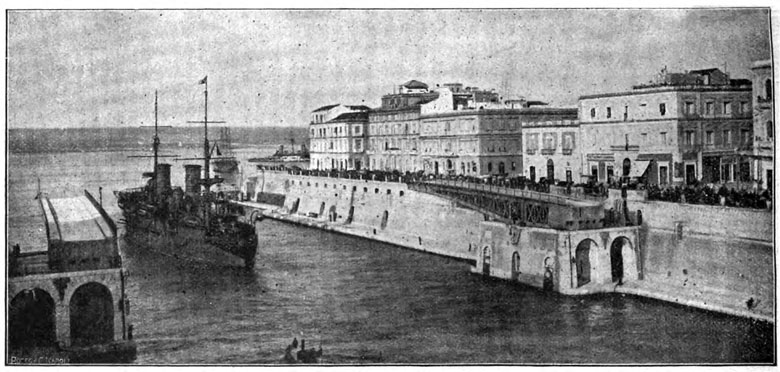
1912
1912
Commercial and shipping lines.
560 ships arrived in Taranto, including domestic and foreign steamers and sailing ships, and 556 departed. The introduction of a number of shipping lines also contributed to port traffic. Before the 1915-18 war, Taranto was served by the London-Bombay shipping line and the Genoa-Venice trade line, with one steamer arriving and one departing every week. The cruiser ``Vettor Pisani`` transits the navigation canal, 1912 from Rassegna Pugliese (Puglian Review) 1913, nr 6-7-8 - http://books.google.com18.Between the two wars (1915-45)
18.Between the two wars (1915-45)

1915
1915
The military port assumes a dominant role over the merchant port
With Italy's involvement in the First World War, Taranto, with its Arsenal and newly-opened Franco Tosi Shipyards, took a leading role in the repair and construction of warships. Salvaging the ship Leonardo da Vinci at the Military Arsenal, 1921. Biblioteca Pubblica Arcivescovile ``A. De Leo`` (The Annibale De Leo Archdiocesan Public Library).
1920 ca.
1920 ca.
Trade and tourist routes to the East and Egypt are reduced.
For a short time, Taranto was one of the stops on the London-Bombay route, but after the First World War only a weekly Taranto - Constantinople - Batum `{`Georgia, one of the largest ports on the Black Sea`}` service and a fortnightly Trieste - Brindisi - Taranto - Alexandria service, operated by Lloyd Triestino, remained. The merchant port in 1918, from Miglioramenti nautici ai porti, canali navigabili, altre opere di pubblica utilità compiute dalla R. Marina durante la guerra (Nautical improvements to ports, navigable canals, other works of public benefit carried out by the Royal Navy during the war), University Library - Genoa - IT-GE0038, www.internetculturale.it https://www.internetculturale.it/jmms/iccuviewer/iccu.jsp?id=oai%3Ateca.liguria.it%3A16%3AIC0005%3ALIG0136873&mode=all&teca=Biblioteca+Digitale+Ligure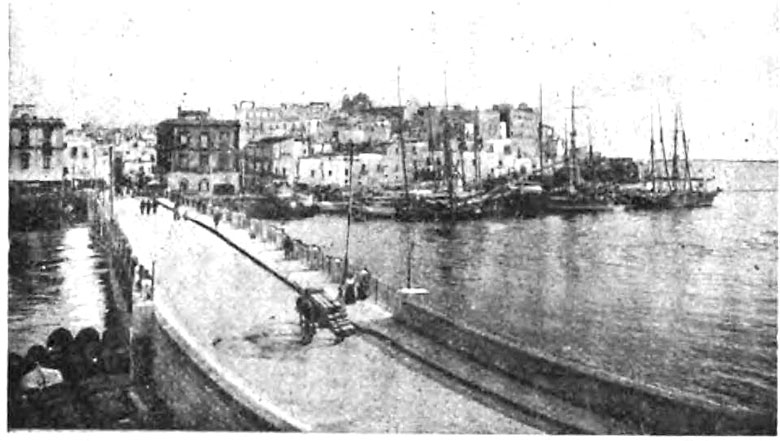
1920 ca.
1920 ca.
The fishing fleet.
In Taranto there was a flotilla of fishing boats with 1,248 sailing and rowing boats operating in the gulf, and 336 engine-powered boats and 27 trawlers fishing along the coast of Calabria. The quantity of the sea fishing catch fluctuated around the 65,000 quintals (6,500 tonnes) per year mark. Even if to a modest extent, fishing also contributed to the port's traffic. Photo of the Merchant Port with moored fishing boats, c. 1910 from Rassegna Pugliese (Puglian Review) 1913 at http://books.google.com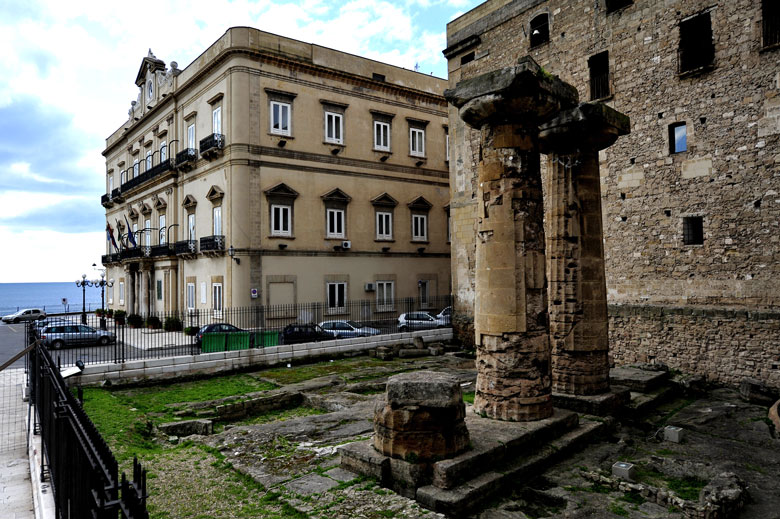
1923
1923
Taranto becomes provincial capital
On 2 September 1923, Taranto stopped being a province of Lecce and became a provincial capital. It had a population of around 100,000 residents, an increase of 60% compared with the census 10 years earlier. Doric columns and the Palazzo di Città (Town Hall), photo by Sergio Malfatti.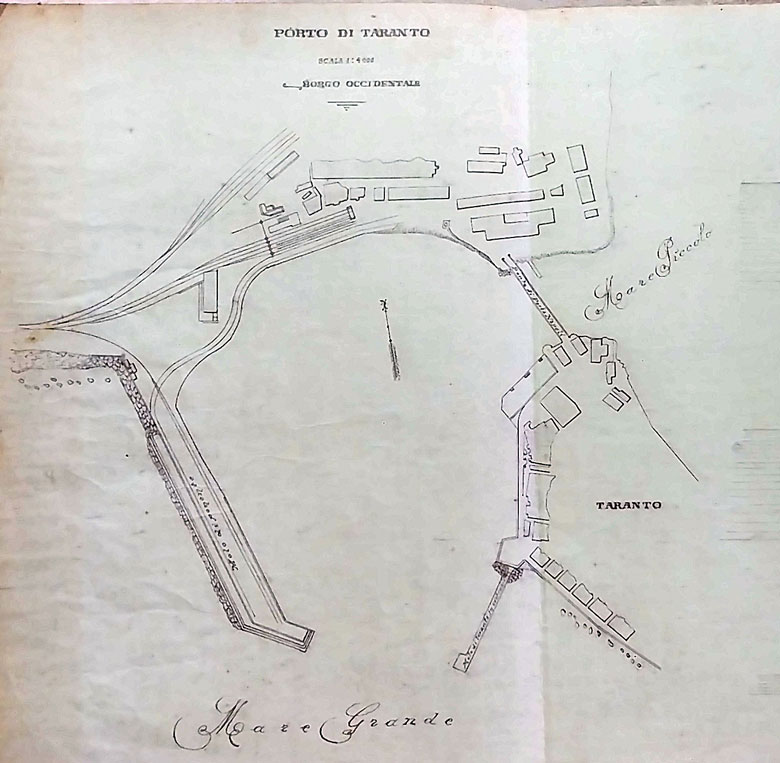
1928
1928
Port traffic
433 ships arrive and depart from the merchant port, handling 209,135 tonnes of goods. Additionally, there are 110,000 tonnes of raw materials required for the shipyards specialising in the construction and repair of merchant ships, tankers and naval vessels. Plan of the merchant port in preparation for maintenance work, 1931. Taranto State Archives.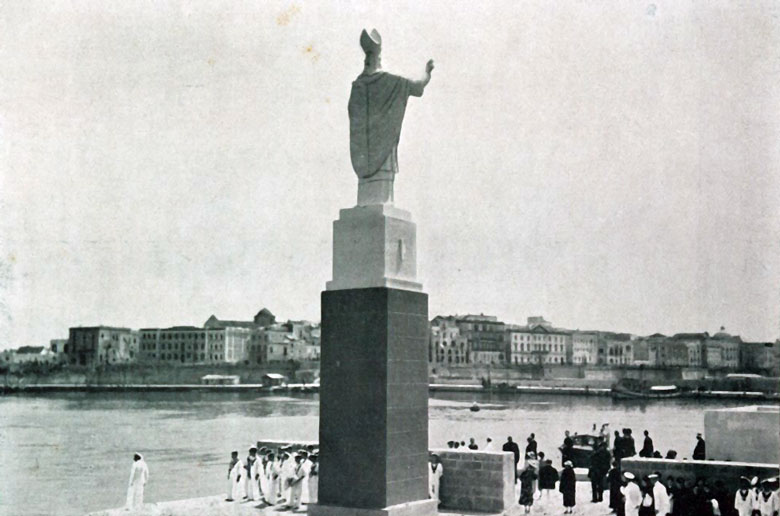
1937
1937
Inauguration of the statue of St. Cataldo in the harbour
In 1937, a statue dedicated to St Cataldo, the city's patron saint, was inaugurated on the main quay. The five-metre-high statue bears a reassuring invocation for seafarers: ``The eye fixed on God, the mind against the wrath of the clouds. For the health of seafarers. The heart for my city. Splendid in faith and glory``. Photo Inauguration of the Statue of St Cataldo at the Western Quay, 30 May 1937 From Rassegna Pugliese (Puglian Review) 1937, a.VI n.1-6 from www.internetculturale.it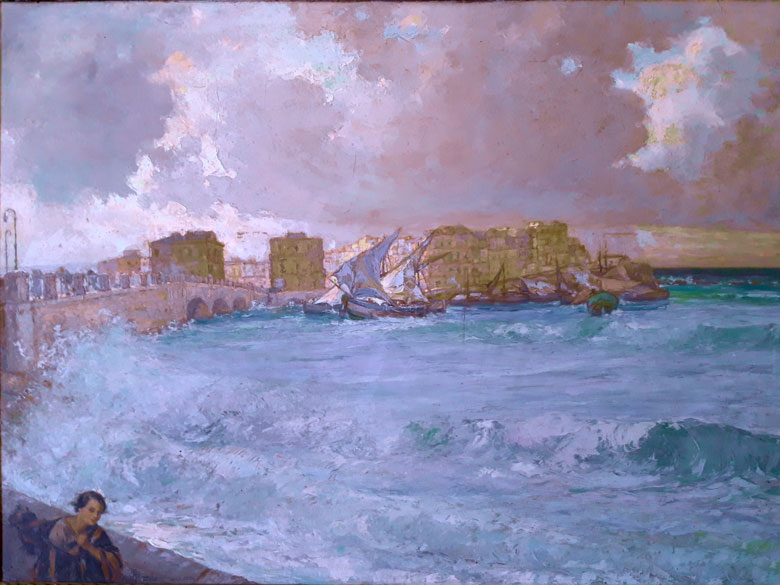
1940
1940
The attack on Taranto
On the night of 11th-12th November, the British Royal Navy bombarded the port of Taranto. The Italian fleet suffered serious damage in the attack, but above all the shelling left 85 dead, 55 of whom were civilians, and 581 people were wounded. View of the marina, canvas by Ciro Fanigliulo, 1932. Palazzo di Città (Town Hall), Taranto.19. Towards the economic boom (1946-1960)
19. Towards the economic boom (1946-1960)
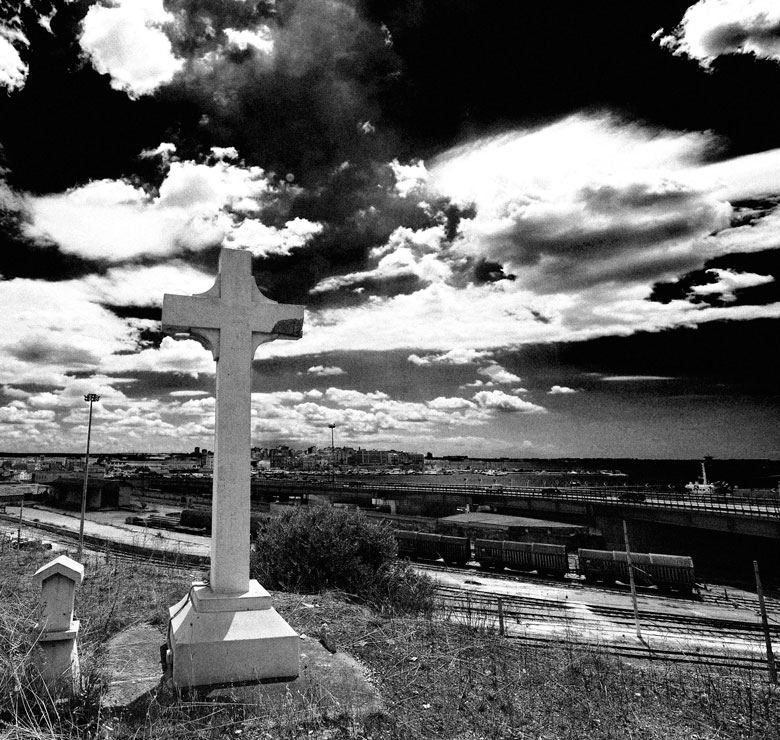
1950 ca.
1950 ca.
The establishment of several food industries.
In the first half of the 20th century, a number of food industries became established in the port, including the Raffo brewery, the Costa oil mill, various local wine producers, and the large Candida-De Matteo bakery. The Ionian Cement factory was also very important, making a considerable contribution to port traffic with an annual production of around 120,000 tonnes of cement. The merchant harbour, viewed from the Cross, photo Sergio Malfatti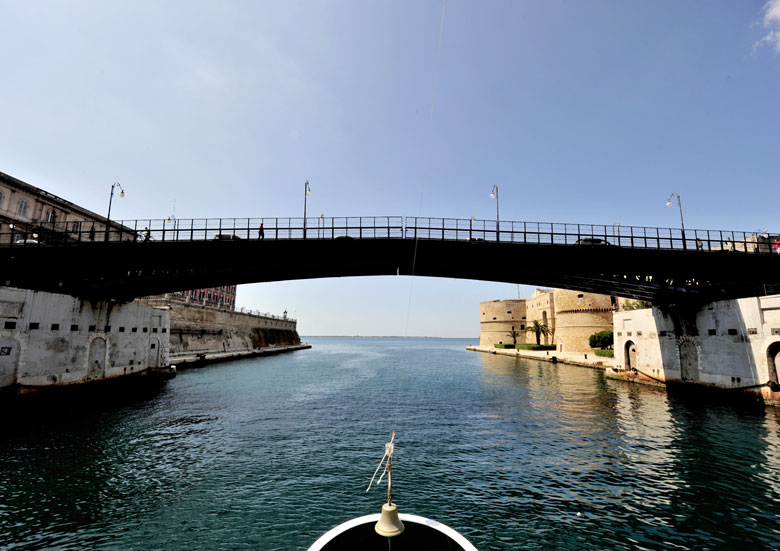
1958
1958
The new swing bridge
The old swing bridge was replaced with a new one. It was inaugurated in the presence of President Giovanni Gronchi. The operation became partly electrified, but the way it works remains unchanged, with hydraulic turbines powered by a large reservoir located on the adjacent Aragonese castle (with a capacity of 600 cubic metres of water) starting the two arms of the bridge as the water falls. The swing bridge, as seen from the navigation canal, photo Sergio Malfatti.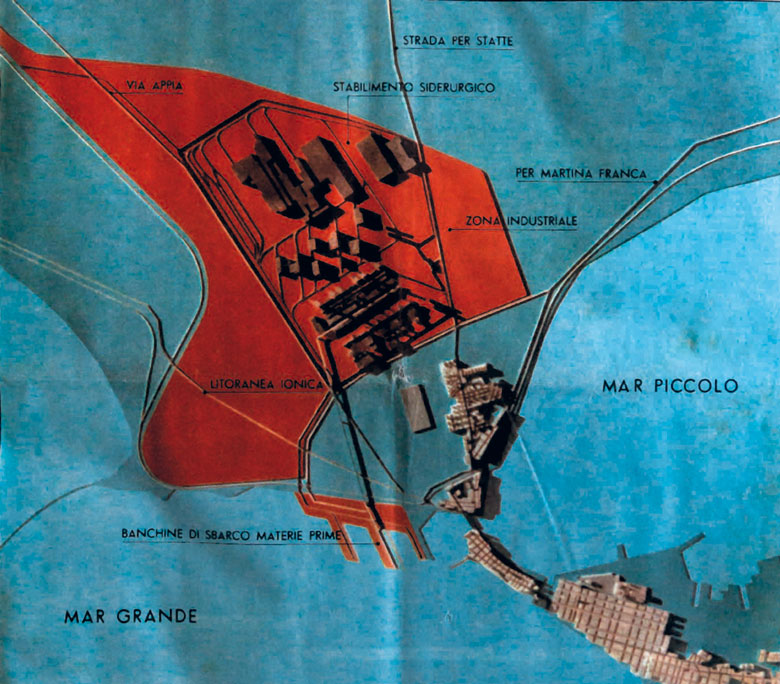
1959
1959
Upgrading of the port: expanding towards the west.
To adapt the port to future needs, a local commission prepared a master plan involving the construction of a new industrial port to the west of the merchant port. Project for the redevelopment of the port in connection with the industrial area, 1959 from Il Corriere del Giorno (The Daily Courier), 9 July 1960 in AA VV, Taranto città a me cara - Moro e Taranto, dagli anni della giovinzza alle visite istituzionali (Taranto, a city close to my heart - Moro and Taranto, from the years of his youth to official visits), Stampasud, Mottola 2017.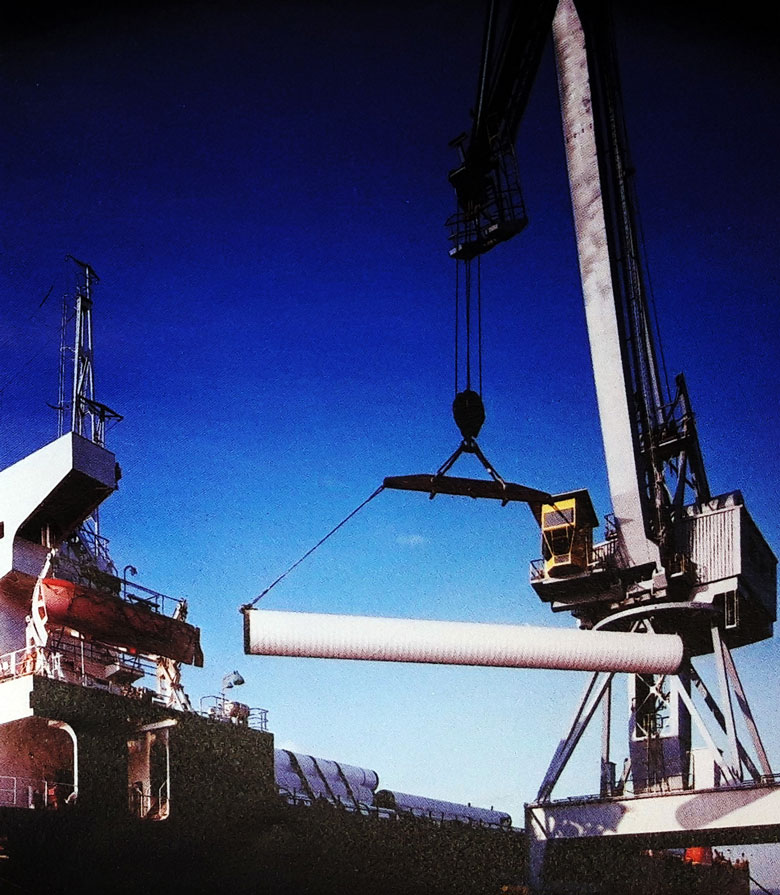
1960
1960
Work begins on the Steel Centre.
9 July saw the laying of the foundation stone for Italsider. Taranto was chosen because it was in an optimal position in relation to the oil markets of the Middle East, importers of the products for which the steel centre is known and highly regarded throughout the world: pipes for oil and gas pipelines, and for large aqueducts. Loading pipes onto a ship by AA VV, Il porto di Taranto (The port of Taranto) (produced by the Office for Research, Projections and Statistical Analysis of the Taranto Port Authority, headed by CF Vincenzo Donvito), Stampasud, Mottola (Ta) 198720. The Second Industrialisation (1961-1994)
20. The Second Industrialisation (1961-1994)
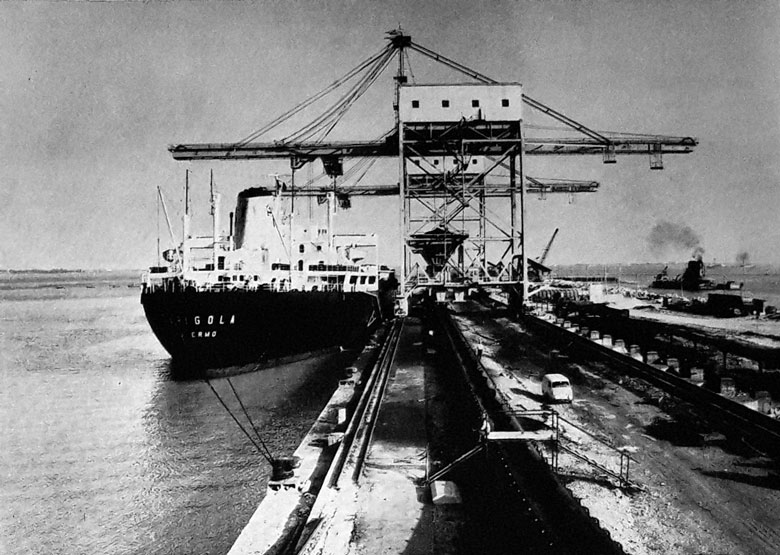
1964
1964
Inauguration of the Steel Centre.
The port area had four piers, of which only the western one had a length of 403 metres and a depth of 8/9 metres. When the Steel Centre became fully operational in 1965, compared to 1959, the year before work began, the transit of merchant ships increased 15-fold. In the first months of 1966 alone there were 950 merchant ships in transit from 24 countries. Goods arrived mainly from the United States, while outgoing goods were mainly shipped to Latin America, Russia and Libya. The Iron and Steel Quay, 1966 from SIMONETTI Michele, Il porto di Taranto - porto di sviluppo industriale del Mezzogiorno (The port of Taranto - Southern Italy's industrial development port), Palombi, Rome 1966.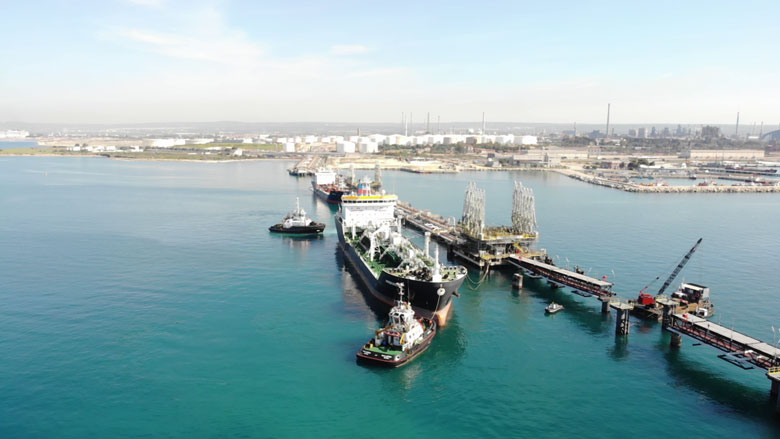
1967
1967
Inauguration of the Refinery.
Work on the construction of the refinery facilities began in October 1965 and was finished in 1967, the year production began. A field of buoys, located in the Mar Grande on a deep seabed, ensures the mooring of oil ships for unloading crude oil, which is sent to the storage tanks by means of a 2,750-metre underwater pipeline. For the shipment of refined products, the refinery has a 1,250-metre long jetty. ENI jetty with the oil refinery in the background, photo ENI.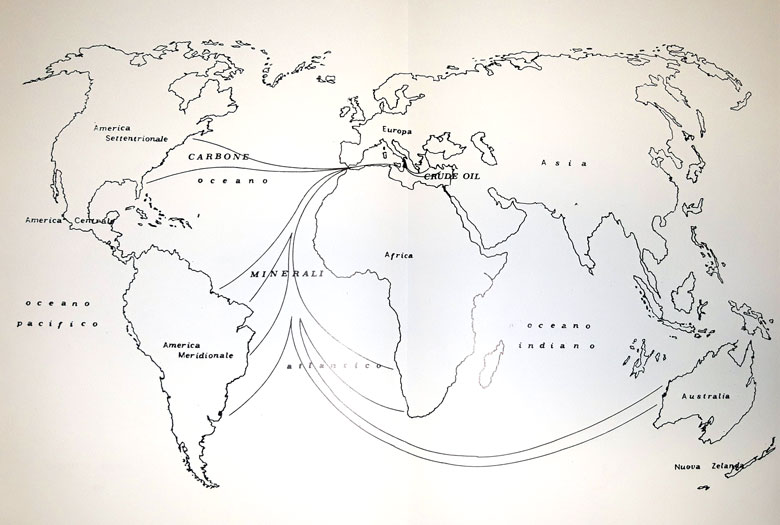
1976
1976
The port comes fourth in the national ranking for goods traffic.
In 1976, the total traffic in the merchant port was about 28 million tonnes of loaded and unloaded goods, whereas in 1970 it was almost 18 million tonnes. These numbers bear no comparison with the pre-industrial phase, e.g. in 1960, when only 181,712 tonnes of goods were handled. The diagram shows the routes of the main areas of origin of raw materials. Map showing the principal places of origin of raw materials, from AA VV, Il porto di Taranto (The port of Taranto) (produced by the Office for Research, Projections and Statistical Analysis of the Taranto Port Authority, headed by Frigate Captain Vincenzo Donvito), Stampasud, Mottola-Taranto 1987.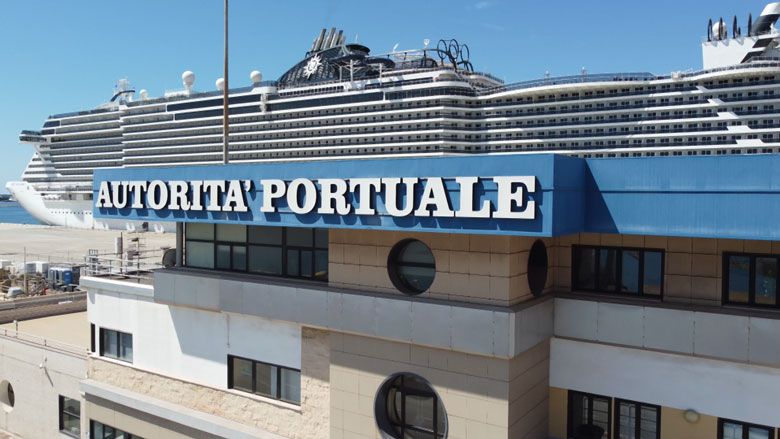
1994
1994


